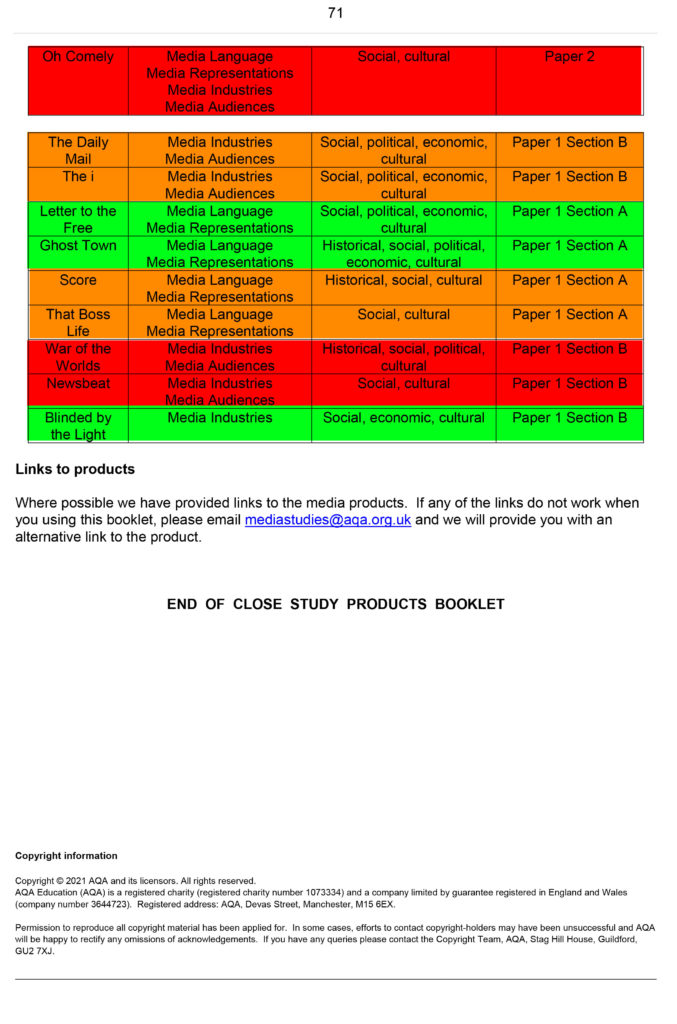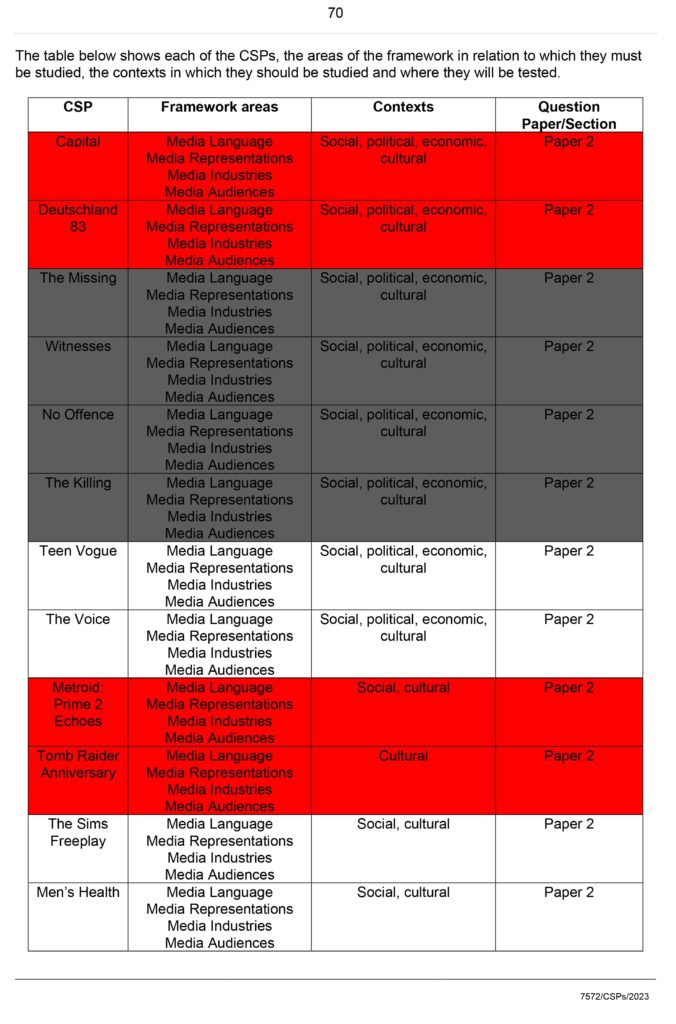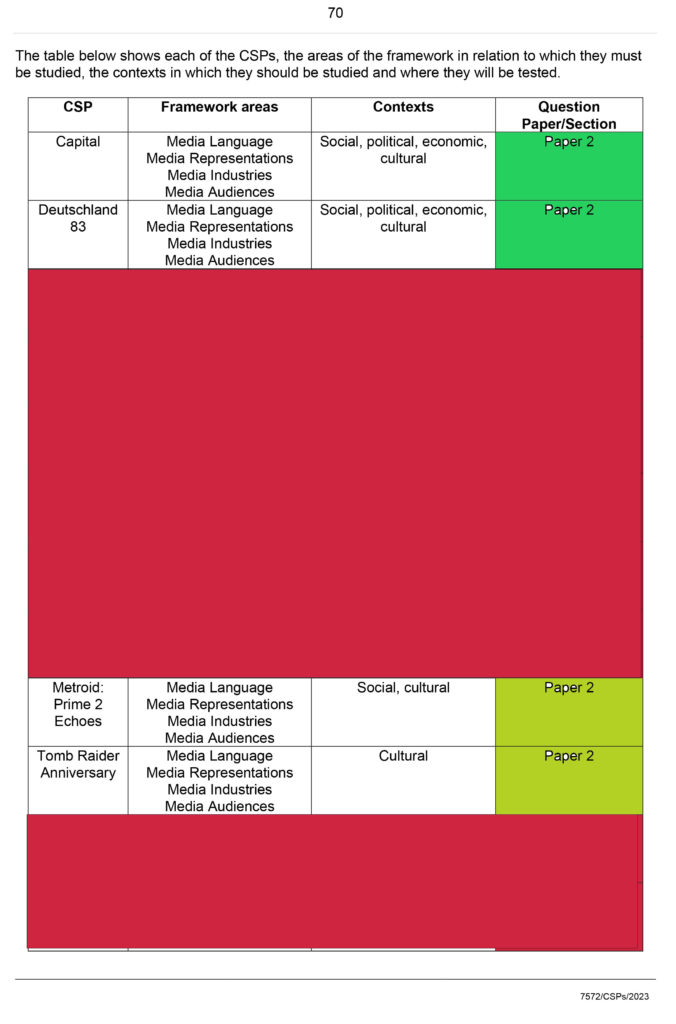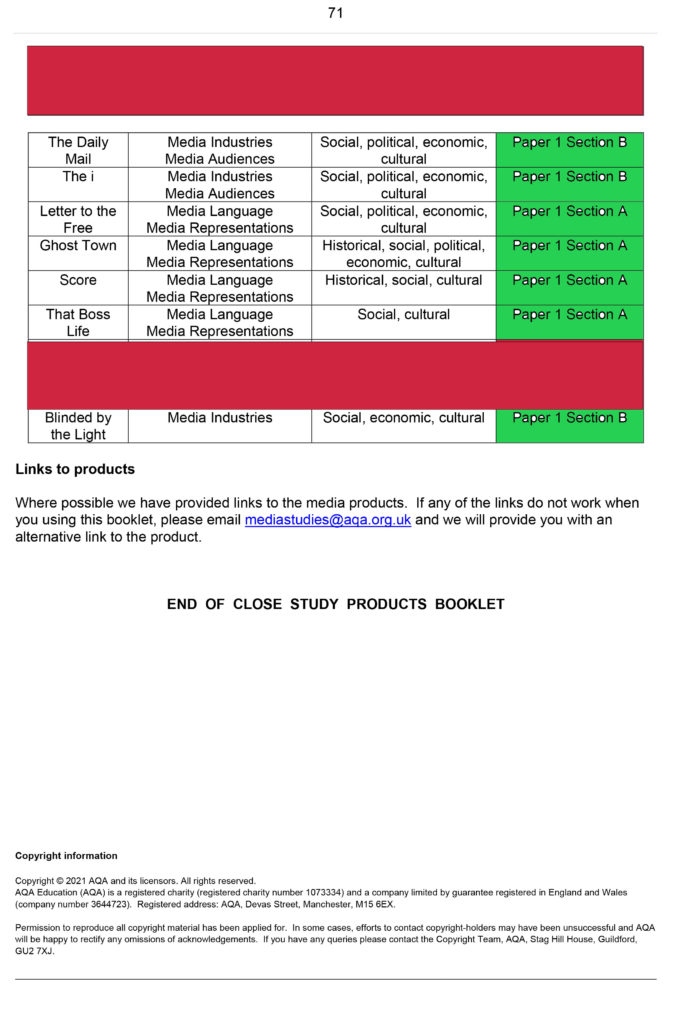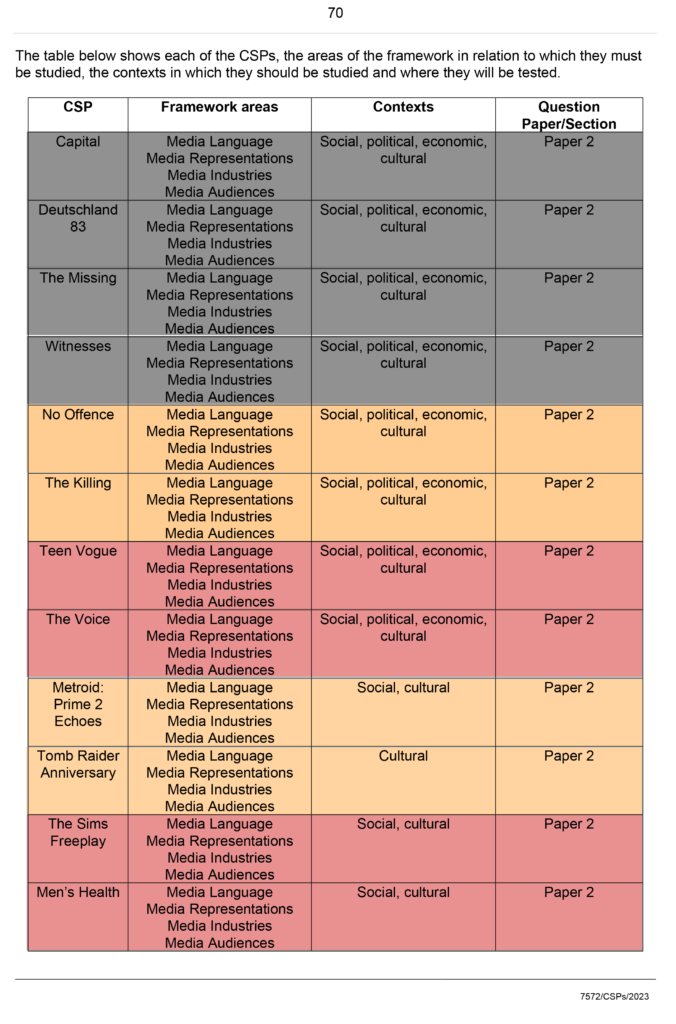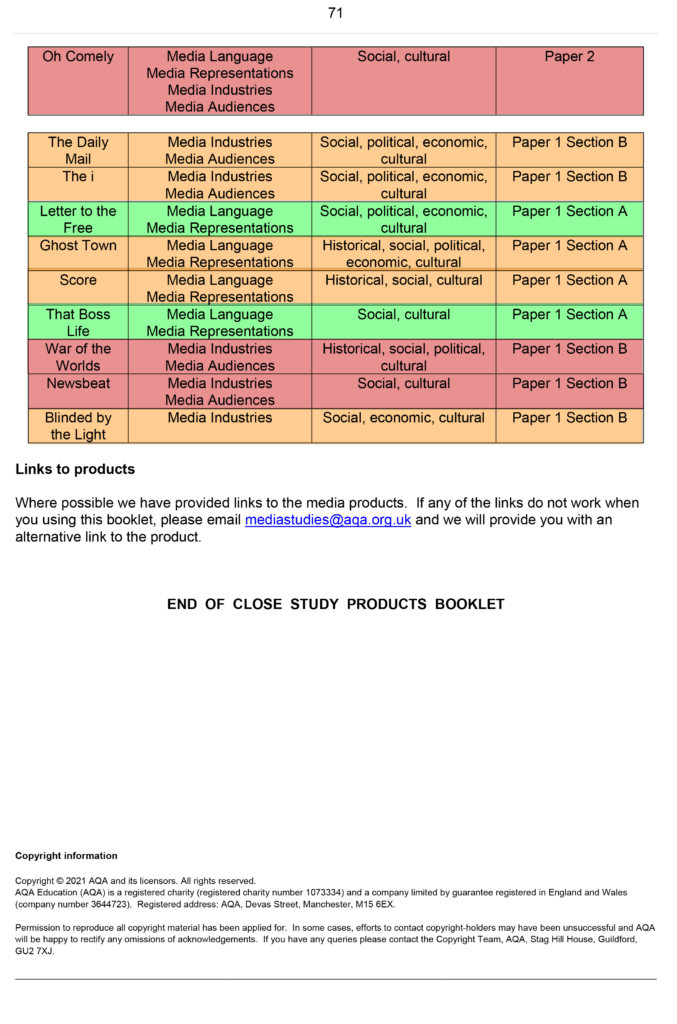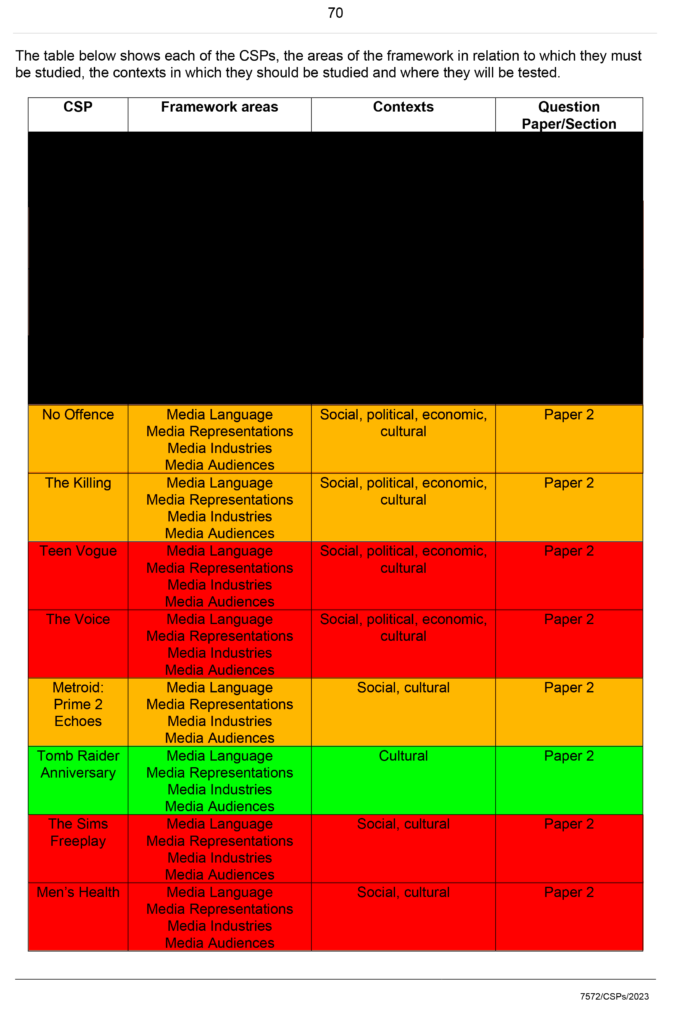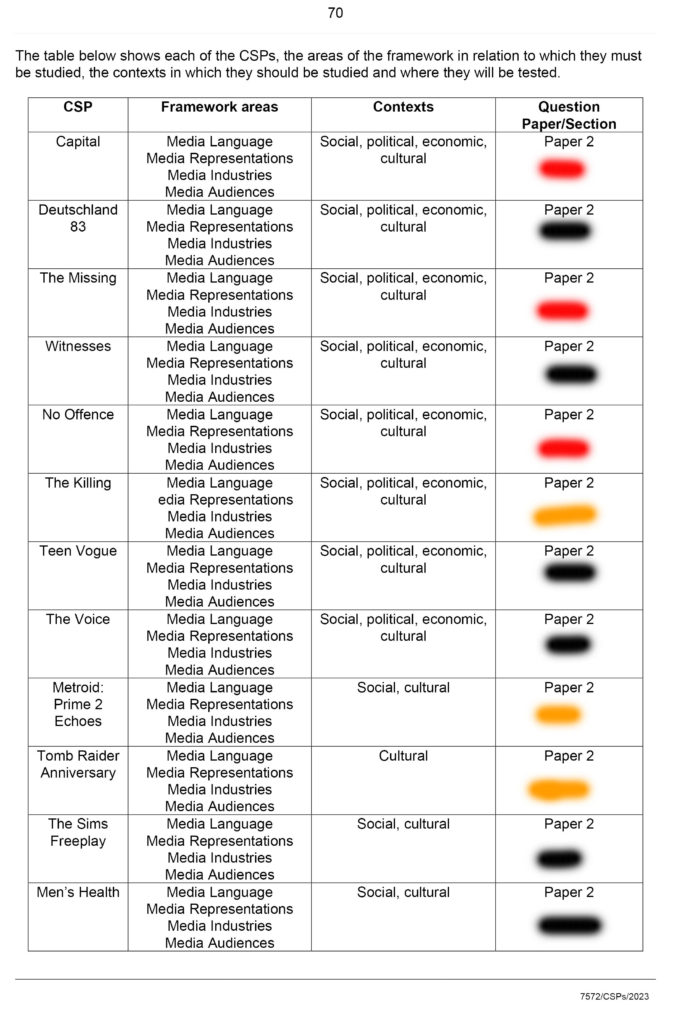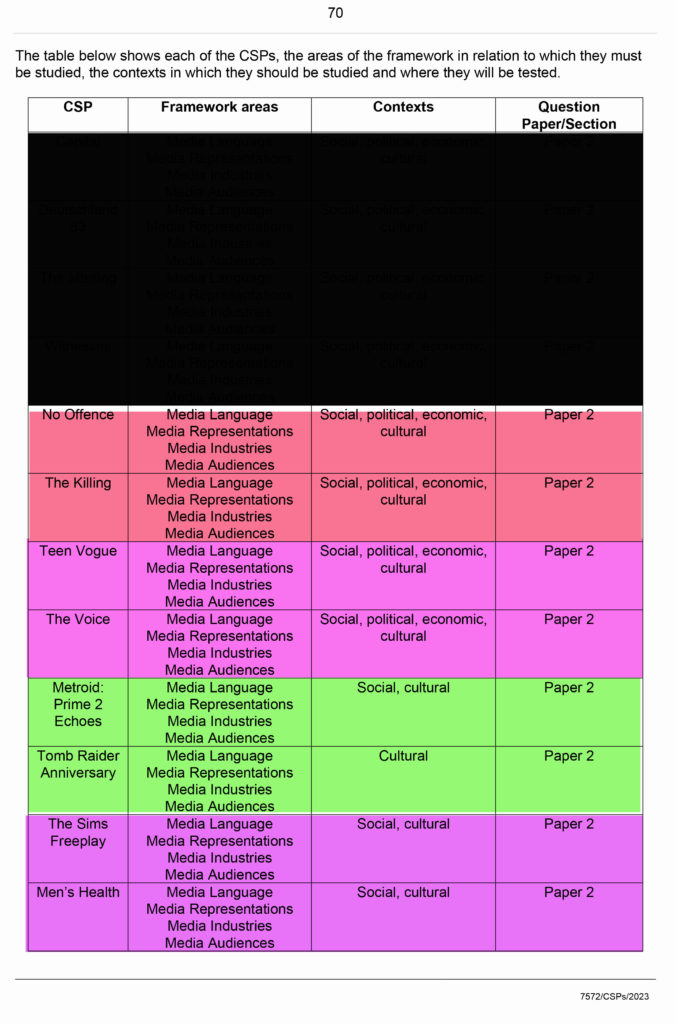LANGUAGE
| SEMIOTICS Sausser | ||
| SEMIOTICS Barthes | The idea that texts communicate their meanings through a process of signification The idea that signs can function at the level of denotation, which involves the ‘literal’ or common-sense meaning of the sign, and at the level of connotation, which involves the meanings associated with or suggested by the sign | |
| SEMIOTICS C. S. Pierce | ||
| SEMIOTICS Baudrillard | in postmodern culture the boundaries between the ‘real’ world and the world of the media have collapsed and that it is no longer possible to distinguish between reality and simulation. The idea that in a postmodern age of simulacra we are immersed in a world of images which no longer refer to anything ‘real’. The idea that media images have come to seem more ‘real’ than the reality they supposedly represent (hyperreality) | SIMS |
| NARRATIVE Todorov | Tripartite narrative structure begining/middle/end equilibrium/disruption/new equilibrium The idea that all narratives share a basic structure that involves a movement from one state of equilibrium to another The idea that these two states of equilibrium are separated by a period of imbalance or disequilibrium The idea that the way in which narratives are resolved can have particular ideological significance | NO OFFENCE THE KILLING METROID TOMB RAIDER MENS OH! |
| NARRATIVE Freytag | ||
| NARRATIVE Bathes | ||
| NARRATIVE Chatman | ||
| NARRATIVE Propp | ||
| NARRATIVE Levi-Strauss | The idea that texts can best be understood through an examination of their underlying structure The idea that meaning is dependent upon (and produced through) pairs of oppositions – binary opposition drives the narrative The idea that the way in which these binary oppositions are resolved can have particular ideological significance | METROID TOMB RAIDER MENS OH! |
| GENRE Neale | genre as audience recognition genre is a mechanism which attracts audience as it is structured around a repertoire of elements genres change as society changes | NO OFFENCE THE KILLING METROID TOMB RAIDER MENS OH! |
| GENRE Schatz | most films fit into one of two genres: Genres of Order – western, gangsta, sci-fi Genres of Integration – musicals, comedy, romance |
REPRESENTATION
| IDENTITY Gauntlett | The idea that the media provide us with ‘tools’ or resources that we use to construct our identities. The idea that whilst in the past the media tended to convey singular, straightforward messages about ideal types of male and female identities, the media today offer us a more diverse range of stars, icons and characters from whom we may pick and mix different ideas Fluid – identity which has the potential to change Negotiated – the process of people coming to an agreement about their identity and other peoples identities Constructed – identity that has been built upon experiences and influences Collective- identity you gain from being part of a group suggests gender is fluid and ever changing | SIMS |
| IDENTITY Hall | The idea that representation is the production of meaning through language, with language defined in its broadest sense as a system of signs The idea that the relationship between concepts and signs is governed by codes The idea that stereotyping, as a form of representation, reduces people to a few simple characteristics or traits The idea that stereotyping tends to occur where there are inequalities of power, as subordinate or excluded groups are constructed as different or ‘other’ (e.g. through ethnocentrism) those to represent the media to us give their insight/view on the subject and therefore we learn more about them, than the subject different representations cause different effects | NO OFFENCE THE KILLING TEEN VOGUE THE VOICE METROID TOMB RAIDER SIMS MENS OH! |
| FEMINIST Mulvey | ||
| FEMINIST Butler | The idea that identity is performatively constructed by the very ‘expressions’ that are said to be its results (it is manufactured through a set of acts). the idea that there is no gender identity behind the expressions of gender. The idea that performativity is not a singular act, but a repetition and a ritual Gender is a social construct | METROID TOMB RAIDER MENS OH! |
| FEMINIST van Zoonen | gender is constructed through discourse, and that its meaning varies according to cultural and historical context. The idea that the display of women’s bodies as objects to be looked at is a core element of western patriarchal culture. the idea that in mainstream culture the visual and narrative codes that are used to construct the male body as spectacle differ from those used to objectify the female. | THE KILLING METROID TOMB RAIDER SIMS MENS OH! |
| FEMINIST hooks | The idea that feminism is a struggle to end sexist/patriarchal oppression and the ideology of domination. The idea that feminism is a political commitment rather than a lifestyle choice. >The idea that race and class as well as sex determine the extent to which individuals are exploited, discrimination against or oppressed | THE KILLING |
| POST COLONIALISM Gilroy | The idea that colonial discourses continue to inform contemporary attitudes to race and ethnicity in the postcolonial era. The idea that civilisationism constructs racial hierarchies and sets up binary oppositions based on notions of otherness. | SIMS |
| POST COLONIALISM Lacan | ||
| POST COLONIALISM Said |
AUDIENCE
| Lasswell | hypodermic needle theory passive consumption Lasswells linear model of communication: sender, message, medium, reciever, effect involves a receiver simply accepting a message being given to them, rather than engage with it Propaganda Technique in the World War which highlighted the brew of ‘subtle poison, which industrious men injected into the veins of a staggering people until the smashing powers… knocked them into submission’ | |
| Lazerfeld | two step flow of communication active consumption media messages are filtered through influential opinion leaders who interpret a message and first and then relay them back to the mass audiences | |
| McQuail, Blumler, Katz | uses and gratifications theory which recognises the decision making process of theory audience, highlighting how they seeking specific uses and gratifications when consuming media hey go through processes of selection, interpretation and feedback processes active selection information / education empathy and identity social interaction entertainment explores/challenges how media messages are produced, circulated and consumed escapism | |
| Hall | explores/challenges how media messages are produced, circulated and consumed The idea that communication is a process involving encoding by producers and decoding by audiences. The idea that there are three hypothetical positions from which messages and meanings may be decoded: the preferred reading, the negotiated reading or the oppositional reading. preferred reading is the producer’s intended message negotiated is when the audience understand the message but adapt it to suit their own values oppositional is where the audience disagrees with the preferred meaning this is due to different audiences and different identities – different age, gender, sexuality, ethnicity, backgrounds etc… a message “must be perceived as meaningful discourse and meaningfully de-coded” before it has an “effect”, a “use”, or satisfies a “need” | NO OFFENCE THE KILLING TEEN VOGUE THE VOICE METROID TOMB RAIDER SIMS MENS OH! |
| Gerbner | cultivation theory passive consumption The idea that exposure to repeated patterns of representation over long periods of time can shape. and influence the way in which people perceive the world around them (i.e. cultivating particular views and opinions) the idea that cultivation reinforces mainstream values (dominant ideologies). examines the lasting effects of media – Looking primarily at the relationship between violence on television and violence in society world syndrome – the cognitive bias whereby television viewers exposed to violent content were more likely to see the world as more dangerous than it actually is suggest that ‘television cultivates from infancy the very predispositions and preferences that used to be acquired from other primary sources‘ (Gerbner et al 1986) ‘television’s major cultural function is to stabilize social patterns and to cultivate resistance to change‘ (1978: 115) mainstreaming – media consumption leads audiences to accept mainstream ideologies contradicted by Gauntlett – believes people only divulge in media that they believe will contribute to finding their individual sense of self – more active audience | NO OFFENCE THE KILLING METROID TOMB RAIDER SIMS |
| Jenkins | The idea that fans are active participants in the construction and circulation of textual meanings. The idea that fans appropriate texts and read them in ways that are not fully authorised by the media producers (‘textual poaching’). The idea that fans construct their social and cultural identities through borrowing and inflecting mass culture images, and are part of a participatory culture that has a vital social dimension | METROID TOMB RAIDER SIMS |
| Shirky | The idea that the Internet and digital technologies have had a profound effect on the relations between media and individuals The idea that the conceptualisation of audience members as passive consumers of mass media content is no longer tenable in the age of the Internet, as media consumers have a now become producers who ‘speak back to’ the media in various ways, as well as creating and sharing content with one another | TEEN VOGUE THE VOICE METROID TOMB RAIDER |
| Bandura | The idea that the media can implant ideas in the mind of the audience directly. ‘modelled learning’ The idea that audiences acquire attitudes, emotional responses and new styles of conduct through modelling. The idea that media representations of transgressive behaviour, such as violence or physical aggression, can lead audience members to imitate those forms of behaviour | SIMS |
INDUSTRY
| Chomsky | -Manufacturing of consent -5 filters of mass media -very small amount of very powerful owners dictate the industry | |
| Habermas | ||
| Curran & Seaton | The idea that the media is controlled by a small number of companies primarily driven by the logic of profit and power The idea that media concentration generally limits or inhibits variety, creativity and quality the idea that more socially diverse patterns of ownership help to create the conditions for more varied and adventurous media productions | |
| Livingstone & Lunt | The idea that there is an underlying struggle in recent UK regulation policy between the need to further the interests of citizens (by offering protection from harmful or offensive material), and the need to further the interests of consumers (by ensuring choice, value for money, and market competition) The idea that the increasing power of global media corporations, together with the rise of convergent media technologies and transformations in the production, distribution and marketing of digital media, have placed traditional approaches to media regulation at risk | SIMS |
| Hesmondhalgh | The idea that cultural industry companies try to minimise risk and maximise audiences through vertical and horizontal integration, and by formatting their cultural products (e.g. through the use of stars, genres, and serials). The idea that the largest companies or conglomerates now operate across a number of different cultural industries idea that the radical potential of the internet has been contained to some extent by its partial incorporation into a large, profit-orientated set of cultural industries | THE KILLING METROID TOMB RAIDER MENS OH! |






